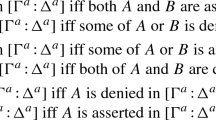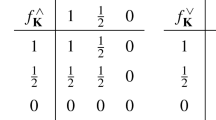Abstract
This paper is an experiment in Leibnizian analysis. The reader will recall that Leibniz considered all true sentences to be analytically so. The difference, on his account, between necessary and contingent truths is that sentences reporting the former are finitely analytic; those reporting the latter require infinite analysis of which God alone is capable. On such a view at least two competing conceptions of entailment emerge. According to one, a sentence entails another when the set of atomic requirements for the first is included in the corresponding set for the other; according to the other conception, every atomic requirement of the entailed sentence is underwritten by an atomic constituent of the entailing one. The former conception is classical on the twentieth century understanding of the term; the latter is the one we explore here. Now if we restrict ourselves to the formal language of the propositional calculus, every sentence has a finite analysis into its conjunctive normal form. Semantically, then, every sentence of that language can be represented as a simple hypergraph, H, on the powerset of a universe of states. Entailment of the sort we wish to study can be represented as a known relation, subsumption between hypergraphs. Since the lattice of hypergraphs thus ordered is a DeMorgan lattice, the logic of entailment thus understood is the familiar system, FDE of first-degree entailment. We observe that, extensionalized, the relation of subsumption is itself a DeMorgan Lattice ordered by higher-order subsumption. Thus the semantic idiom that hypergraph-theory affords reveals a hierarchy of lattices capable of representing entailments of every finite degree.
Similar content being viewed by others
References
Leibniz, G.W.F.: Discourse on metaphysics; Correspondence with Arnauld; and, Monadology. Open Court, Kegan Paul, Trench, Trubner (Chicago, London) (1902)
Leibniz, G.W.: Logical Papers. trans. and ed. by G. H. R. Parkinson. Clarendon Press, Oxford (1966)
Anderson A.R., Belnap N.D.: Tautological entailments. Philos. Stud. 13, 9–24 (1961)
Anderson, A.R., Belnap, N.: Entailment. The Logic of Relevance and Necessity, vol. 1. Princeton University Press, Princeton (1975)
Dunn J.M.: Intuitive semantics for first-degree entailments and ‘coupled trees’. Philos. Stud. 29, 149–168 (1976)
Routley R., Routley V.: The Semantics of first degree entailment. Noûs 6, 335–359 (1972)
Belnap N.D.: Intensional models for first degree formulas. J. Symb. Log. 32, 1–22 (1967)
Jeffrey R.C.: Formal Logic: Its Scope and Limits. McGraw-Hill Book Company, New York (1967)
Jennings, R.E., Chen, Y.: Articular models for first degree entailment (in press, 2009)
Chen, Y., Jennings, R.E.: The unity of clutters: the representation of higher-degree entailments in hypergraph semantics. (in press 2011)
Author information
Authors and Affiliations
Corresponding author
Additional information
The research presented in this paper is supported by SSHRC research grant # 410-2008-2330.
Rights and permissions
About this article
Cite this article
Jennings, R.E., Chen, Y. & Sahasrabudhe, J. On a New Idiom in the Study of Entailment. Log. Univers. 5, 101–113 (2011). https://doi.org/10.1007/s11787-011-0027-4
Received:
Accepted:
Published:
Issue Date:
DOI: https://doi.org/10.1007/s11787-011-0027-4




